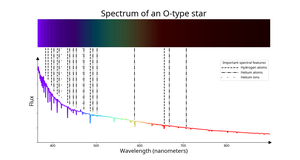Glossarbegriffe: O-Stern
Description: Ein Stern mit der Spektralklasse "O". Astronomen erkennen Sterne vom Spektraltyp O daran, dass in ihren Spektren Absorptionslinien von ionisiertem Helium zu sehen sind. Sie haben typische (effektive) Temperaturen zwischen etwa 10.000 Kelvin (K) und 30.000 K. Im Vergleich zu anderen Sternen erscheinen sie dem menschlichen Auge bläulich-weiß, außer Extinktionseffekte (entweder durch die Erdatmosphäre oder durch das interstellare Medium) spielen eine Rolle. Sterne vom Typ O sind die heißesten und blauesten Sterne auf der Hauptreihe im Hertzsprung-Russell-Diagramm. O-Sterne auf der Hauptreihe haben die höchsten Massen (mehr als 15 Sonnenmassen) und die kürzeste Lebensdauer beim Wasserstoffbrennen und sind daher meist in und um Sternentstehungsgebiete zu finden.
Zugehörige Glossarbegriffe:
- Wasserstoffbrennen
- Hauptreihe
- Spektralklasse
- Sternentstehung
- Reddening
- Effektivtemperatur
- Absorptionslinie
See this term in other languages
Term and definition status: The original definition of this term in English have been approved by a research astronomer and a teacher The translation of this term and its definition is still awaiting approval
The OAE Multilingual Glossary is a project of the IAU Office of Astronomy for Education (OAE) in collaboration with the IAU Office of Astronomy Outreach (OAO). The terms and definitions were chosen, written and reviewed by a collective effort from the OAE, the OAE Centers and Nodes, the OAE National Astronomy Education Coordinators (NAECs) and other volunteers. You can find a full list of credits here. All glossary terms and their definitions are released under a Creative Commons CC BY-4.0 license and should be credited to "IAU OAE".
Related Diagrams
Spectrum of an O-type star
Bildnachweis: IAU OAE/SDSS/Niall Deacon
License: CC-BY-4.0 Creative Commons Namensnennung 4.0 International (CC BY 4.0) icons









